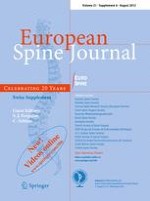Published in:

01-08-2012 | Original Article
Anterior short correction in thoracic adolescent idiopathic scoliosis with mini-open thoracotomy approach: prospective clinical, radiological and pulmonary function results
Authors:
Kan Min, Mathias Haefeli, Daniel Mueller, Georg Klammer, Frederik Hahn
Published in:
European Spine Journal
|
Special Issue 6/2012
Login to get access
Abstract
Introduction
This is a prospective study of adolescent patients in whom idiopathic thoracic scoliosis was corrected by short anterior fusion through a mini-open thoracotomy approach. Clinical, radiological and pulmonary function results of minimal 2-year (2–6) follow-up are presented.
Materials and methods
Consecutive 62 patients with Lenke 1 and 2 curves, having main thoracic scoliosis of up to 75°, were prospectively included. The shoulder imbalance in Lenke 2 patients was less than 20 mm. Thoracic scoliosis was corrected by short anterior fusion. The thoracic spine was exposed by an 8-cm mini-open thoracotomy incision. The operation technique and choosing of fusion levels are thoroughly described. Complete 360° discectomies and convex side vertebral endplates osteotomies are essential for deformity corrections with short fusions. Single-rod 5.5-mm titanium implants were used. The age at the time of operation was mean 15.2 years; 56 patients had a single thoracic curve and 6 patients had a double thoracic curve. There were almost equal numbers of patients with lumbar modifier A, B or C. The average length of fusion was 5.5 (4–7) vertebrae. The average length of fusion was 3.5 (2–6) vertebrae shorter than the average curve length.
Results
The instrumented thoracic curves improved by 58.3% at 6 weeks and 56.3% at the last follow-up. Apex thoracic vertebral rotation improved by 73.78% at 6 weeks and 76.24% at the last follow-up. The non-instrumented upper thoracic curve improved by 25% in double thoracic scoliosis, where the mid-thoracic curve was selectively fused, and the non-instrumented lumbar curves improved by 33.9% at the last follow-up. The radiological changes from 6 weeks to the last follow-up were statistically not significant. The clinical rib hump improved by 54% at the last follow-up. There were no significant changes in the pulmonary function. FVC% was 81.04% preoperatively, 76.41% at 6 months and 80.38% at the 2-year follow-up. The results of SRS 24 questionnaire improved from a total of 61.40 points preoperatively to 100.50 points at 6 months and 98.62 points at the 2-year follow-up. There were no neurological or thoracotomy related complications, no pseudarthrosis, no implant pullout or breakage.
Conclusion
A good deformity correction without loss of correction or adding on, a good cosmetic result and good patient’s satisfaction were achieved through shorter than end-to-end thoracic fusions. The radiological residual deformity is acceptable. Anterior correction of thoracic scoliosis with a short spinal fusion is recommended to keep the large part of the spine mobile. A very short fusion, small thoracotomy incision, low-profile implants and complete closure of parietal pleura are keys to prevent reduction in postoperative lung function.





